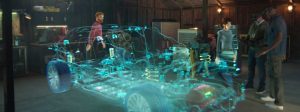Microsoft Mesh the future of virtual collaboration
During Microsoft Ignite last week, Microsoft showcased the future of virtual collaboration through Microsoft Mesh. Microsoft Mesh enables presence and shared experiences from anywhere, on any device, using mixed reality applications. This powerful collaboration platform goes beyond the constraints of traditional 2D video calls, bringing users together in a way that simulates physical presence.
In its current preview mode, Microsoft Mesh features digital avatars of users gathered around a holographic table. This virtual table allows users to present both 2D and 3D models. Similar to existing mixed reality capabilities, users can manipulate object sizes, adjust their perspective, and place annotations on these models. A notable addition introduced by Mesh is the ability to save work, including point of view settings, 3D model dimensions, and annotations. This functionality enables seamless continuation of work by allowing subsequent users to pick up where the previous user left off.
Another remarkable aspect of Microsoft Mesh is its device-agnostic nature. The platform is designed to facilitate connections from various devices, including HoloLens, Oculus and other VR headsets, mobile phones, tablets, and PCs. While Microsoft suggests using HoloLens and Mixed Reality for optimal experiences, Microsoft Mesh is intended to be accessible from a wide range of devices.
During the introduction, certain key features were highlighted as future possibilities. One is the use of actual human holograms instead of avatars. This innovation would create a presence that genuinely replicates the feeling of being in the same room with others. Another anticipated feature is the integration of Microsoft Mesh with Microsoft Teams and Dynamics 365. This integration could revolutionize team meetings, transforming them into virtual mixed reality environments where participants interact as if they were physically present, rather than participating in conventional 2D video calls.
Lastly, Microsoft Mesh envisions the use of holograms to replace physical prototypes, as demonstrated with the example of cars in the accompanying image. This application of Mesh has the potential to significantly enhance business processes, saving time, money, and resources. Current practices often require physical meetings or the distribution of physical prototypes to team members. Microsoft Mesh streamlines these inefficiencies. With Mesh, when a new 3D prototype is ready, teams can convene within a few hours, rather than waiting for days or weeks to produce a physical model.

You can currently preview Microsoft Mesh on HoloLens 2, a Mesh-enabled version of AltSpaceVR, and, in the future, through the SDK for developers. The current preview offers a basic user interface with limited functionality, but it provides a tantalizing glimpse into the future of virtual collaboration as envisioned by Microsoft Mesh.


